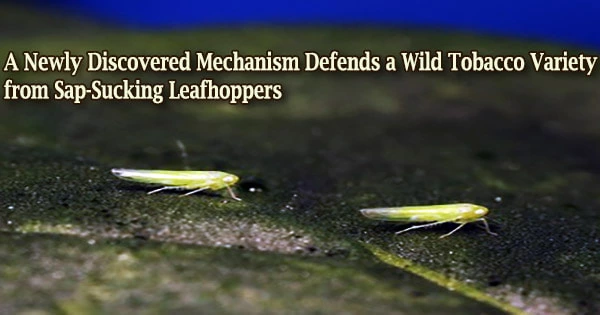Plants are at the bottom of the food chain, and diseases and herbivorous insects are constantly threatening them. However, due to widespread plant resistance, commonly known as non-host resistance, the vast majority of assailants are unable to inflict any damage. This is a long-term and effective resistance.
The mechanisms that contribute to resistance, particularly against herbivorous pests, are, nevertheless, largely unexplored. Researchers at the Max Planck Institute for Chemical Ecology have identified a chemical component responsible for Nicotiana attenuata plants’ resistance to sucking leafhoppers (Empoasca spp.) and the genes required for its production in a recent study.
“Our research uncovered how native plants use chemical reprogramming to defend themselves against opportunistic leafhoppers in nature,” first author Yuechen Bai says, summarizing the results.
In field research conducted in 2004, scientists at the institute observed that tobacco plants with a faulty defense-signaling cascade based on the plant hormone jasmonic acid were attacked by leafhoppers, insects that are normally unable to affect tobacco plants with functional defenses.
The research demonstrated that in nature, plants are constantly “examined” by herbivorous insects to see if they can function as a food source; yet, most plants are able to defend themselves effectively.
Another study by the institute confirmed similar findings, showing that leafhoppers colonized the plants in wild tobacco populations with a lower jasmonic acid signaling pathway than other tobacco plants.
“However, at that time, it was still unknown which specific defense mechanisms triggered by jasmonic acid were responsible for resistance to the leafhoppers,” explains Dapeng Li, one of the study leaders.
To find an explanation, the researchers crossed 26 genetically distinct natural parental lines. This population was placed in its native environment in Arizona, USA, where it may be attacked by opportunistic leafhoppers, after the study team had crossed it according to a set method over a period of nine years.
The severity of the damage caused by leafhoppers assisted in identifying the genetic underpinnings that made this particular plant a host plant for leafhoppers exploiting weak defenses.
The researchers also looked into which chemical changes occur in the plants following an attack, as well as which genes are triggered. They discovered a new unstable chemical called CPH (caffeoylputrescine-green-leaf-volatile compound), which was responsible for leafhopper resistance that was persistent.
By combining sophisticated molecular biology and chemical analysis methods, we were able to identify and characterize not only a previously unknown defense substance, but also the genes responsible for its synthesis; Our approach can be described as natural history-guided forward genetics. Natural history and the observation of the feeding behavior of leafhoppers has driven our discovery process. Because when it comes to chemistry, nature remains the mother of invention.
Ian Baldwin
They were able to show which three metabolic pathways were involved in the creation of this chemical utilizing bioinformatic detective work and plants that were selectively changed in certain defense and signal transduction genes.
Finally, the researchers were able to recreate the defense chemical CPH’s biosynthesis pathway in two related plants, the field bean Vicia faba and the tomato species Solanum chilense, as well as demonstrate its efficiency against leafhoppers.
“By combining sophisticated molecular biology and chemical analysis methods, we were able to identify and characterize not only a previously unknown defense substance, but also the genes responsible for its synthesis,” explains Ian Baldwin, and continues:
“Our approach can be described as natural history-guided forward genetics. Natural history and the observation of the feeding behavior of leafhoppers has driven our discovery process. Because when it comes to chemistry, nature remains the mother of invention.”
Further research is needed to determine how the synthesis of this chemical defense is coordinated in the plant, as well as what additional elements and specific regulators are required for its development, particularly under natural conditions.
By sucking on the leaves of immature plants and transferring viral infections, leafhoppers of the genus Empoasca, particularly the potato leafhopper Empoasca fabae, can inflict significant crop damage.
The spread of these insects has been hampered by rising temperatures. This basic research on how to handle a pest like this can provide vital insights on how to increase crop resistance in the long run, especially in light of the new demands on agriculture brought on by climate change.





